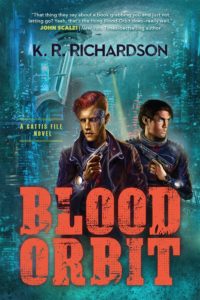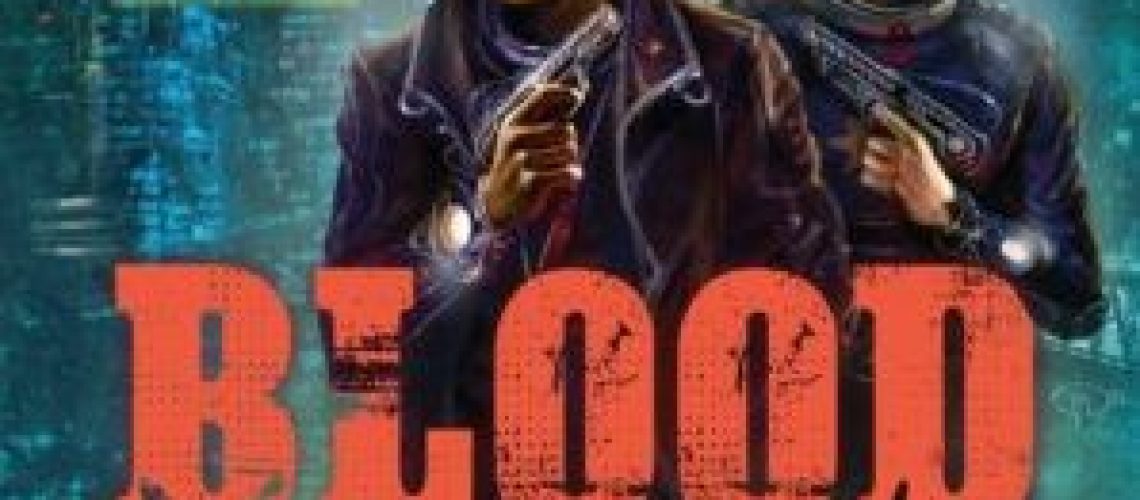I don’t recall exactly what drew me to picking Blood Orbit out of the many options for potential reviewing here. Likely it was a combination of good experience/trust in the publisher and the description of a crime noir/science fiction blend, a combo of two of my beloved genres. I certainly didn’t recognize the name of the author, and upon finally beginning the novel I had no memory of what that blurb said it was even about. I started reading the electronic copy Pyr had provided expecting a typical slow start. Without the ease of a physical copy I find getting into a novel really challenging while trying to ‘turn’ back to firmly get characters or the seeds of plot to stick in mind. Instead I found little need for that, and my finger tapped through pages in a focused rush to read more. Blood Orbit is exceptionally crafted from its opening, and at no point through its last page did I ever end up feeling like it faltered. Happening to be at Barnes & Noble at the time, I soon decided to get up and just get the actual book, because I already had a feeling this “Gattis File” debut would be one series I’d want to keep up with.

Now, well after finishing the novel, I discover that the author “K.R.” is a not-so-secretive pseudonym for Kat Richardson, the best-selling author of the “Greywalker” paranormal detective series. The choice for publishing Blood Orbit pseudo-pseudonymously seems mainly to forewarn fans that this is a different series, with science fiction elements instead of urban fantasy and its own unique aspirations. I’ve not read Kat Richardson proper to have any opinion regarding comparison of this to her established work. But “K.R.” Richardson certainly impresses by balancing the entertaining plots and characters of popular bestsellers with crisp, talented writing, all while intelligently incorporating complex, socially relevant themes into a crime/SF mashup.
Blood Orbit opens cinematically as rookie cop Eric Matheson and his training officer discover a grisly scene of mass murder in the the criminal underbelly of the Dreihleat, a depressed ethnic quarter of Angra Dastrelas, capital of the corporate-owned planet Gattis. The authorities appear eager to swiftly conclude the case by assigning blame on the obvious culprits of the massacre, the Ohba. Another repressed ethnic minority of Gattis, the Ohba are often at odds with the Dreihle. However, J.P. Dillal, the cybernetically-enchanced investigator assigned the case as Chief Investigating Forensic Officer, remains skeptical of ethnic motivations, observing signs of evidence to the contrary. With parentage one part Ohba and one part Dreihle, Dillal has unique theoretical insight into the politics of the case. Practically, however, neither community accepts him. Similarly, his fellow officers view him with distrust both due to his heritage and the controversial cybernetic modifications he has volunteered to receive and test. Dillal thus hand-picks Matheson to help him in the investigation, despite Matheson’s desire to stay out of the limelight and escape the stature afforded him through his powerful family. What begins as a routine, if difficult, investigation slowly becomes more personal and dangerous for both Matheson and Dillal as they uncover the truth behind the massacre and seedy corporate corruption that seeks to keep ethnic minorities oppressed at any cost.
Richardson’s novel is clearly an ambitious one that juggles mystery, speculation, politics, invented cultures, with the action of a complex plot and characters. She nails all of this by combining purposeful pacing with deeply fleshed-out characters. As mentioned, the novel begins with cinematic descriptions and action that immediately introduce the reader to a main character, establish a gritty tone, and offer a dip into the worldbuilding of its future setting on an alien world with physically and culturally distinct ethnic populations. These come while setting up the plot, but Richardson wisely keeps this start limited to Matheson, the class in power, and the Dreihle. Only once the reader is given a bit of time to be comfortable with these ingredients does Richardson expand to add Dillal, the Ohba, and other important secondary characters.
This kind of slow building in characters and their world is tempered with regular ebbs and flow of action interspersed with the type of dialogues one would expect in a police procedural, or necessary for relation of science fiction information like the nature/history of Dillal’s cybernetic implants. Despite this careful plotting, reading Blood Orbit does not give the reader any sense of artifice. In large part this is because Richardson hides her guiding hand by keeping readers focused and invested in complex characters that go through significant development, particularly Matheson. All of them subvert being pigeonholed into any cliché or expectation. Even the recognizable femme fatale common to noir serves not just the traditional role, but exists as more in Blood Orbit.
With its Chinatown vibe, readers of crime fiction will find much to love in the novel. At the same time it will also appeal to science fiction fans. Dillal’s forensic enhancements are one aspect of technological appeal, but the real speculative beauty of Blood Orbit lies in the development of its varied cultures, particularly language. The English among the dominant class of Gattis is just slightly modified from our current speaking, while the ethnic minorities have each developed unique deviations and quirks. Notably these differences seem to have developed within the ethnic groups of Gattis so that these groups could retain individually and some measure of control/power as repressed minorities. This is just one kind of detail that Richardson builds into Blood Orbit to form its dominant theme, namely how an individual’s assumptions based on social structures and politics can lead to errors both small and large: personal, familial, organizationally, globally, and beyond.
Generalities of Blood Orbit’s ending might be predicted by some readers, but not likely with such specificity to negate the novel’s elements of mystery or to undercut the surprising reveals that are vital to the developments of Matheson and Dillal. A mediocre or disappointing finale has reduced many potentially fantastic novels to the realms of merely good. But Richardson crafts a resolution that wholly satisfies, organically and faithfully fulfilling the lead-up in a manner neither overly dark nor hopeful.
The only significant criticism of Blood Orbit I could find while reading it sprang from a desire to see more of the worldbuilding: to learn more about the Dreihle and the Ohba and to see a wider expanse of the universe Gattis inhabits. I soon realized, however, that this wasn’t even necessarily a criticism as much as a testament to Richardson’s ability to mete out information patiently. The closing chapters of the novel begin to open things wider, like it or not, to build a successful series. While functioning completely on its own, Blood Orbit hints at even more to reward readers who return for a continued story. I’ll be looking forward to that. And if the “Gattis Files” isn’t already optioned for a TV series even just one book in, someone should get on that pronto.







